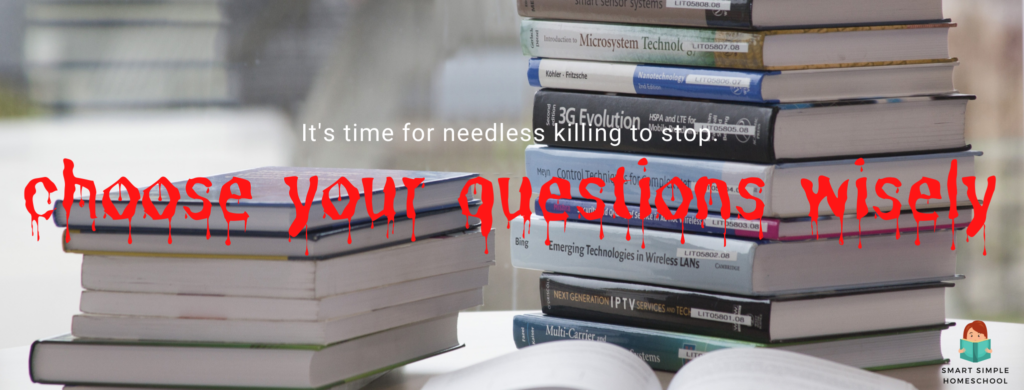
What’s in Huck Finn’s pocket on page 57?
You don’t know?
Neither did I in 10th grade literature class. And you know what? It still bothers me today. I had read the book and those that know me know I read it closely, it’s my nature. Yet, I got to class and the quiz for the day knocked me flat. It was the first time I realized that traditional comprehension questions don’t build excellent readers – they kill readers.
Killing readers sounds harsh. You may be thinking, “Surely, it isn’t that bad.” Oh, but it is my friends. Traditional comprehension questions do have a place as readers learn to pay attention to the details of the story but they should be carefully chosen from only the most critical of information in the book. Why? Because when we ask questions about minor, unimportant details, we teach our children that reading is only about memorizing details. We teach them that reading is busy work. We teach them that only the obscure is worth remembering.
I for one don’t want to raise readers who feel this way. Rather I want them to see that reading is about having the opportunity to spend time with the text, roll the content around in your brain, and make decisions with and without the guidance of anyone else. Reading is critical thinking. Reading is seeing how your past experiences shape the thoughts you have about the world around you. Reading is personal.
Learning to read to learn is one of the hardest educational mindset shifts any person has to navigate. It is in these precious moments that children can first see reading is personal. It is in these moments that a love for reading is fostered or killed. So, how do you foster a love instead of hate? You ask the questions that encourage deep personal thinking, encourage using prior knowledge, encourage connecting to what is happening, encourage questioning, encourage reading between the lines. Sound like something that a seven year old is too young to do? I assure you, they are not. They are old enough to have opinions, thoughts, and prior experiences. They are old enough to think about what they know and how the text agrees or disagrees with their world view. They are old enough to ask tough questions and wade through possible answers.
They are old enough. But, are you ready for the hard conversations? Are you ready for them to disagree with you? Are you ready to have independent thinkers in your home or classroom? I hope your answer is yes.
Let’s not rely on questions with simple answers. Let’s make metacognition [thinking about thinking] become a common practice in our homes and classrooms. Let’s stop killing readers with trivial comprehension questions.
Not sure how to make the shift? I’ve got you. If you’re curious about this idea of to learning how to build up readers by teaching them thinking strategies, join me in my free Facebook group called Kick the Curriculum: Confidently Teach Reading with Any Book. Ready to try out a few of these strategies today? Join our mailing list here and get access to a free PDF of starting questions you can use with any book. Sure you don’t have time to figure this all out on your own? I’ve got you too. Check out my collection of novel studies that are print and go. Each study is carefully designed to avoid the trivial and encourage interaction with the text. Where every you fall on the spectrum, you can do this! Even if you don’t use these strategies yourself, you can do this.
Keep it smart. Keep it simple. Keep it meaningful.
Recent Comments